Spain
Preparedness
Pandemics Plan
In Spain, crisis management was initially assumed by the Ministry of Health and Consumption in 2004, through the so-called Coordination System for Alerts and Emergencies of Health and Consumption (SICAS in Spanish) to coordinate detection, information and logistical support to the National System Health in health alert situations. In 2013, a new National Early Warning and Rapid Response System (SIAPR) was created, and since then assumed the functions of coordination, notification, evaluation and epidemiological intelligence, among others.
In 2005, the Spanish health authorities approved a National Plan for the Preparation and Response to a Flu Pandemic, motivated by the risk of a pandemic due to the H5N1 avian influenza virus. With some updating in subsequent years, this same plan has continued to be the roadmap for the covid-19 health crisis in Spain. [1] The document sets out all the possible scenarios and divides them into phases that establish, in a very detailed way, the procedures that should be followed in the event that Spain suffered an outbreak of the flu or any other virus. Despite dating back to 15 years ago, several experts agree that this document could have been sufficient to address the Covid-19 health emergency if it had been strictly adhered to and if public health had had sufficient means and had not suffered major cuts that came after the 2008 economic crisis.
In 2005, the Spanish health authorities approved a National Plan for the Preparation and Response to a Flu Pandemic, motivated by the risk of a pandemic due to the H5N1 avian influenza virus. With some updating in subsequent years, this same plan has continued to be the roadmap for the covid-19 health crisis in Spain. [1] The document sets out all the possible scenarios and divides them into phases that establish, in a very detailed way, the procedures that should be followed in the event that Spain suffered an outbreak of the flu or any other virus. Despite dating back to 15 years ago, several experts agree that this document could have been sufficient to address the Covid-19 health emergency if it had been strictly adhered to and if public health had had sufficient means and had not suffered major cuts that came after the 2008 economic crisis.
Health System
Among other lessons, this crisis has reminded all nations the need to maintain a strong healthcare system. However, when it comes to public health investment, Spain has been at the tail of its European neighbors for years. In Spain, in 2017, per capita healthcare expenditure was of 2,371 euros, a 15% below the European Union average of 2,884 euros. This figure represented a 8.9% of the Spanish GDP, again below the EU average (9.8%). [2]
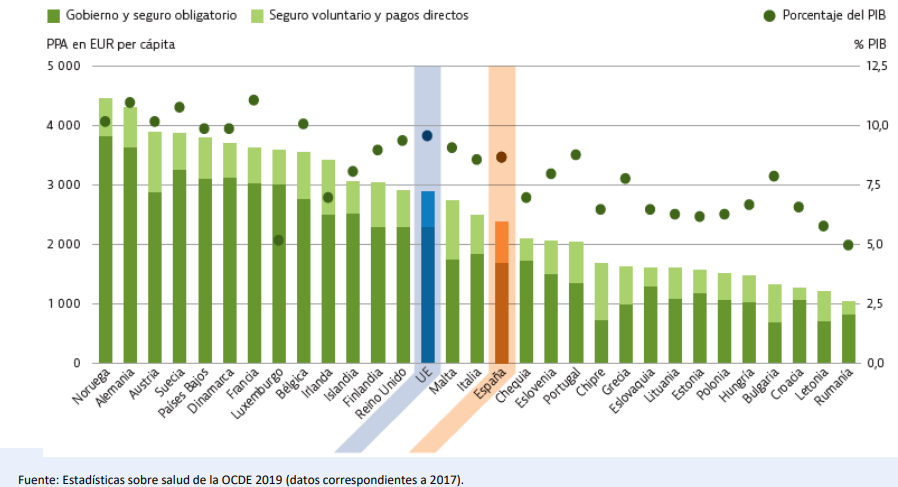
Following the 2009 economic crisis and the prolonged subsequent recession, healthcare spending declined in Spain for several years before growing again in 2014, strongly weakening the Spanish healthcare system.
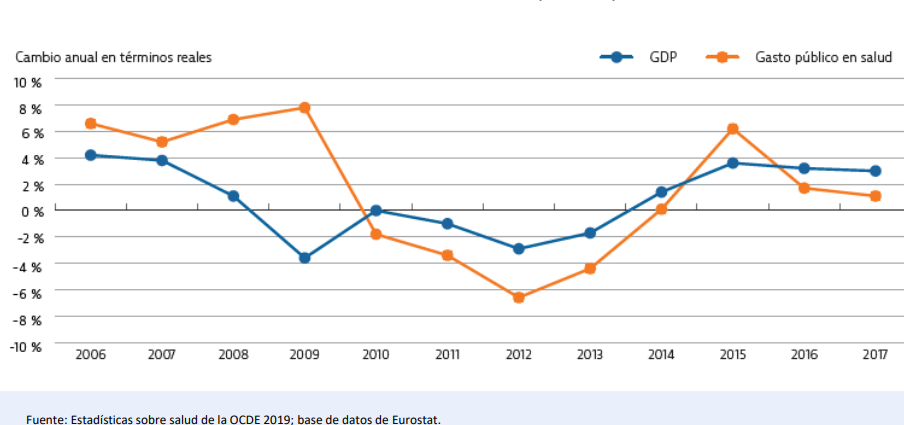
To better appreciate the capacity of the health system, we can use the number of hospital beds available per inhabitant as an indication of the resources available to provide services to hospitalized patients. According to OECD data, in Spain there are 3 beds per 1,000 inhabitants, a figure similar to that of its neighbours Portugal (3.4) and Italy (3.2) and below many others as Greece (4,2), Belgium (5,6), France (6), Austria (7,4) or Germany (8). [3]
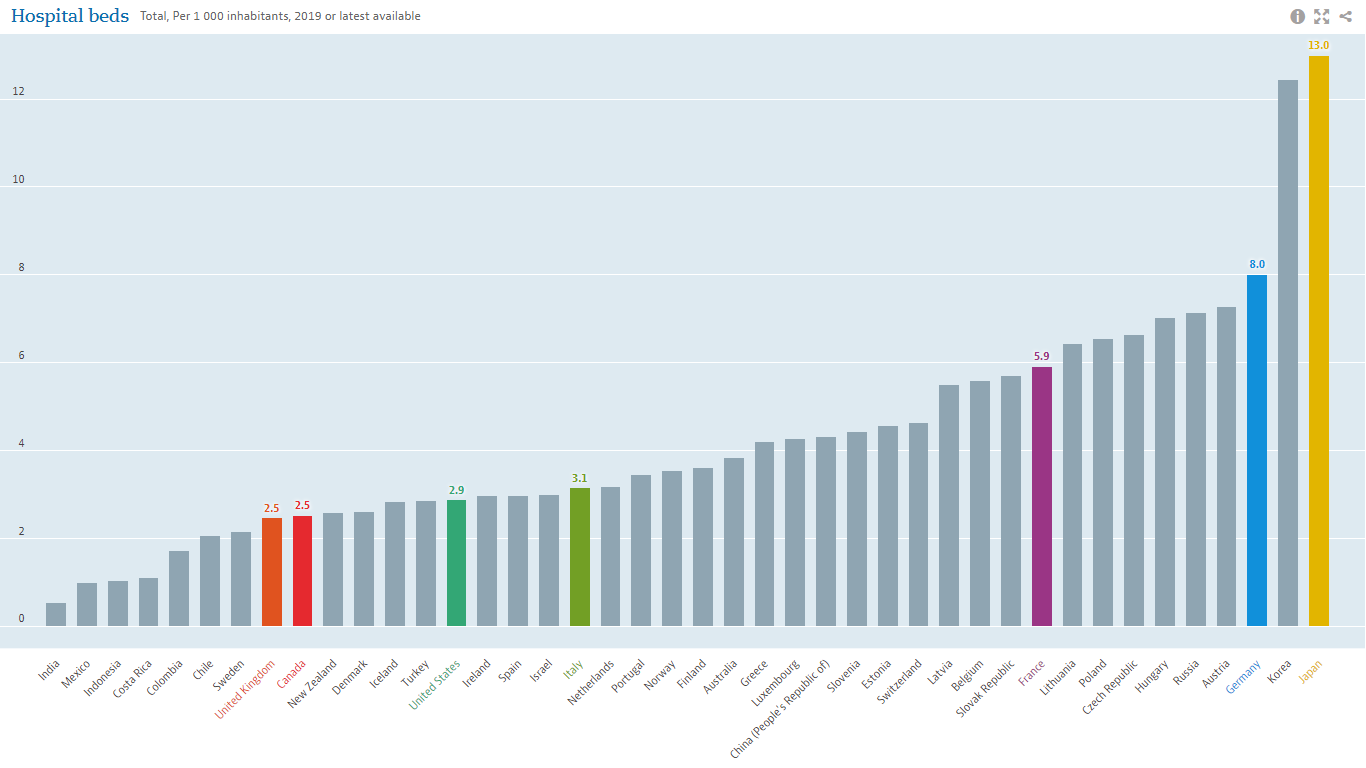
Sense making
Infections, cured and deaths figures over time
The first Spanish infection case came to light on January 31, 2020, when a German tourist in La Gomera tested positive for SARS-CoV-2. It was followed by the case of a British man in Mallorca who also tested positive on February 9. On February 24, after the COVID 19 outbreak in Italy, Spain confirmed several cases related to the Italian clusters, starting with a doctor from Lombardy who was on vacation in Tenerife. The first death in Spain related to the SARS-CoV-2 virus was reported on March 4, while the number of infections continue to increase to 674 people on March 8. As of March 18, there were 11,826 confirmed cases in 1,028 recovered patients and 533 deaths in Spain, according to the authorities. The number of infections and deaths have continued to greatly grow exponentially until present. The peak in the number of deaths was reached on April 2, 2020, when the Ministry of Health reported 950 new deaths within 24 hours. Also, the peak on the number of infected cases was reached on March 25 with more than 9.000 new confirmed cases. [4]
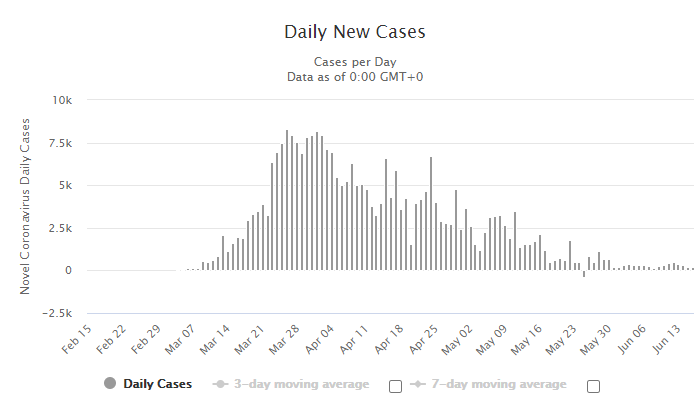
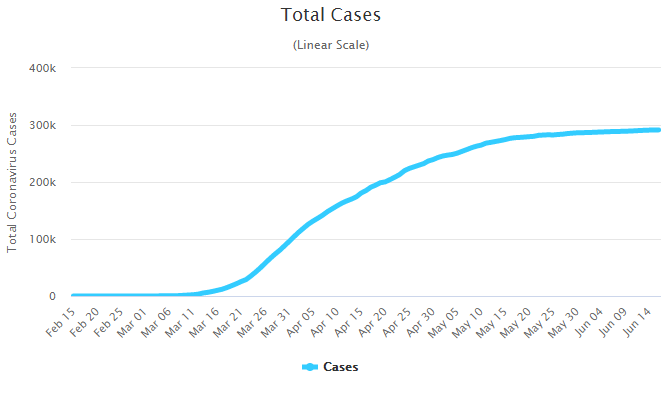
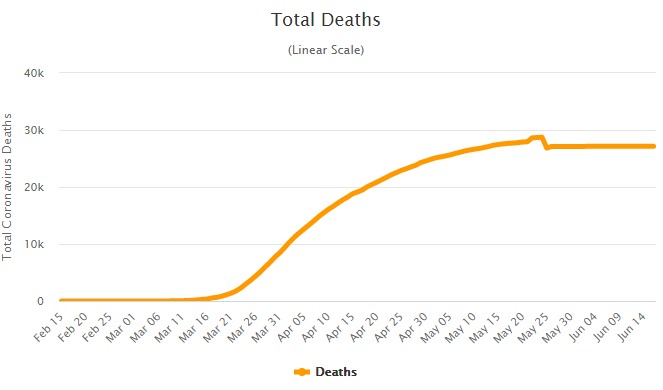
Also, it can be observed the significant differences regarding the impact of the virus in the different 17 Spanish Autonomous Communities. While Madrid and Cataluña have been by large the two Communities most hardly affected by the virus, it can be appreciated the great difference in the number of figures in comparison with the other Communities. [5]
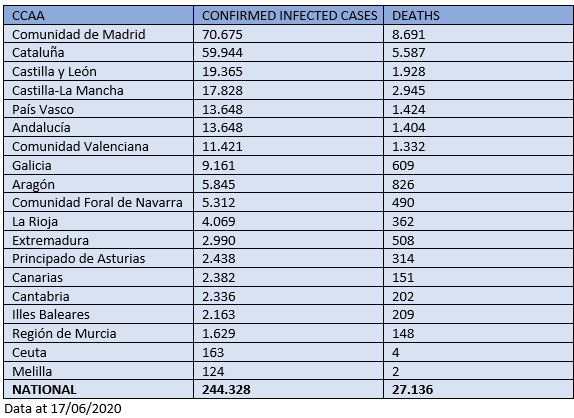
Testing and reporting logic
Like many nations across the world trying to measure the toll that the coronavirus pandemic has taken, Spain has been stymied by unreliable figures. This task is being specially challenging both because the rapid increase in the number of infections and deaths as well as the great amount of people affected but without symptoms. In the first week of April, the Spanish Ministry of Health also held that 15 out of 16 infections, “more than 90%”, had so far remained undetected and were not part of the number of cases reported to date; there would be a very high number of unreported cases. Also, in the case of Spain, this task has had the additional challenge of requiring the mix of the information not only from both public and private hospitals and residences but also from the different Autonomous Communities -in charge of counting and reporting the figures of their respective territory-.
Infections and tests
As Professor Dietrich Rothenbacher, Director of the Institute of Epidemiology and Medical Biometrics at the University of Ulm in Germany, points out, most countries are not conducting tests in a widespread and systematic way, which obviously increases the chances of under-registration. Germany, for example, has been noted for the high number of tests performed, which include potential asymptomatic patients, while in Italy the official guidance is that "in the absence of symptoms” tests realization had no priority.
One of the main priorities of the Spanish state has been the early detention of cases with capacity of transmission by using the PCR tests. Any person with suspected SARS-CoV-2 infection (anyone with a clinical picture of acute respiratory infection, fever, cough, or feeling short of breath as the main symptoms) will undergo a PCR1 (or other molecular diagnosis considered adequate) in the first 24 hours. In case of persons with severe acute respiratory infection and a clinical and radiological picture compatible with COVID-19 but negative or inconclusive PCR results, IgM detection could be considered using a serological test. [6] Also, while in the US, post-mortem testing is left to the discretion of forensic scientists, it is prohibited in Spain.
The CCAA’s public health units have the obligation of declaring their number of confirmed cases with an urgent character. This information will be sent to the state level through the SiViEs surveillance tool managed by the National Centre for Epidemiology. Necessary adaptations of the different sanitary and epidemic surveillance informatic systems have been made to allow the National Network of Epidemiological Surveillance (RENAVE in Spanish) access to diary-actualised information needed for decision-making.
At present (9 July) 5.877.120 tests have been realized in the country, including 2.027.419 antibody tests and 3.849.701 PCR tests, which means 81.73 tests for every 1,000 inhabitants. Taking data from the OCDE, by the end of April, Spain had realized 28.6 tests per 1,000 inhabitants -above the OCDE mean: 22.9-, reaching the eight position in the ranking of tests above countries like Norway, Austria, Denmark, the UK and the USA. [7]
Deaths
The number of coronavirus-related deaths in the major countries affected by the pandemic is one of the major issues of debate since the disease began to spread. Nor only there is no common method (making comparison between countries difficult) but also experts already point out that not all deaths are being properly counted. In many countries, the main problem is that the first official figures on the coronavirus only include victims who had been diagnosed with covid-19 before their death, leaving out the dead who were never tested.
In the case of Spain, in opposition to the procedure of other countries like France -where the counting was changed in early April to add nursing home deaths, raising in this way the count by more than 3,000 deaths-, the number of deaths by covid-19 provided by the Ministry of Health only counts people who have undergone a diagnostic test and that were in hospitals, while it didn’t include the persons died in their homes or residences and to which tests were not made. At the beginning of April, the regional government in Madrid estimated that almost 3,500 people had died in its nursing homes after displaying probable symptoms of the virus, but, since they had not been tested, they had not been included in the official tally for Madrid nursing homes.
However, overmortality is monitored. Civil registers, which data are collected by the Mortality Monitoring System (MoMo) of the Carlos III Health Institute, are used as an alternative tool for calculating overmortality with respect to the expected number of deaths of a certain period of the year (based on deaths figures from previous years).
Between 1 March and 2 June, 43,866 more deaths than expected in a normal situation were recorded in Spain, which is a 42% excess. This includes 27,934 confirmed deaths from covid-19, but there are another 15,932 recorded in the civil registers that do not count as victims of the virus although many will be. [8]
Infections and tests
As Professor Dietrich Rothenbacher, Director of the Institute of Epidemiology and Medical Biometrics at the University of Ulm in Germany, points out, most countries are not conducting tests in a widespread and systematic way, which obviously increases the chances of under-registration. Germany, for example, has been noted for the high number of tests performed, which include potential asymptomatic patients, while in Italy the official guidance is that "in the absence of symptoms” tests realization had no priority.
One of the main priorities of the Spanish state has been the early detention of cases with capacity of transmission by using the PCR tests. Any person with suspected SARS-CoV-2 infection (anyone with a clinical picture of acute respiratory infection, fever, cough, or feeling short of breath as the main symptoms) will undergo a PCR1 (or other molecular diagnosis considered adequate) in the first 24 hours. In case of persons with severe acute respiratory infection and a clinical and radiological picture compatible with COVID-19 but negative or inconclusive PCR results, IgM detection could be considered using a serological test. [6] Also, while in the US, post-mortem testing is left to the discretion of forensic scientists, it is prohibited in Spain.
The CCAA’s public health units have the obligation of declaring their number of confirmed cases with an urgent character. This information will be sent to the state level through the SiViEs surveillance tool managed by the National Centre for Epidemiology. Necessary adaptations of the different sanitary and epidemic surveillance informatic systems have been made to allow the National Network of Epidemiological Surveillance (RENAVE in Spanish) access to diary-actualised information needed for decision-making.
At present (9 July) 5.877.120 tests have been realized in the country, including 2.027.419 antibody tests and 3.849.701 PCR tests, which means 81.73 tests for every 1,000 inhabitants. Taking data from the OCDE, by the end of April, Spain had realized 28.6 tests per 1,000 inhabitants -above the OCDE mean: 22.9-, reaching the eight position in the ranking of tests above countries like Norway, Austria, Denmark, the UK and the USA. [7]
Deaths
The number of coronavirus-related deaths in the major countries affected by the pandemic is one of the major issues of debate since the disease began to spread. Nor only there is no common method (making comparison between countries difficult) but also experts already point out that not all deaths are being properly counted. In many countries, the main problem is that the first official figures on the coronavirus only include victims who had been diagnosed with covid-19 before their death, leaving out the dead who were never tested.
In the case of Spain, in opposition to the procedure of other countries like France -where the counting was changed in early April to add nursing home deaths, raising in this way the count by more than 3,000 deaths-, the number of deaths by covid-19 provided by the Ministry of Health only counts people who have undergone a diagnostic test and that were in hospitals, while it didn’t include the persons died in their homes or residences and to which tests were not made. At the beginning of April, the regional government in Madrid estimated that almost 3,500 people had died in its nursing homes after displaying probable symptoms of the virus, but, since they had not been tested, they had not been included in the official tally for Madrid nursing homes.
However, overmortality is monitored. Civil registers, which data are collected by the Mortality Monitoring System (MoMo) of the Carlos III Health Institute, are used as an alternative tool for calculating overmortality with respect to the expected number of deaths of a certain period of the year (based on deaths figures from previous years).
Between 1 March and 2 June, 43,866 more deaths than expected in a normal situation were recorded in Spain, which is a 42% excess. This includes 27,934 confirmed deaths from covid-19, but there are another 15,932 recorded in the civil registers that do not count as victims of the virus although many will be. [8]
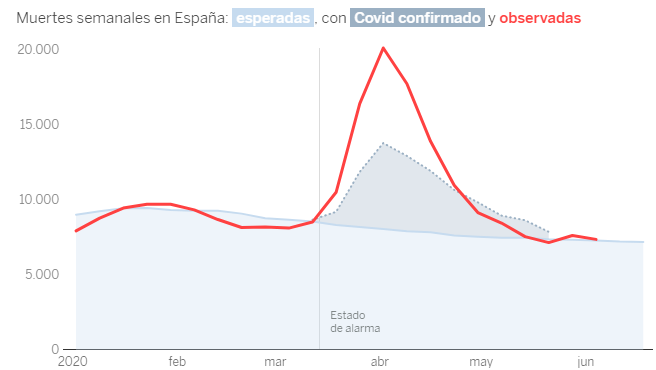
Decision making
Measures adopted
In March 2020, after the OMS officially declared the COVID-19 as a pandemic and in front of the great exponential increment in the number of infections, the Spanish government -a coalition government between two leftist parties, PSOE and Podemos, headed by Pedro Sánchez- started to adopt different measures at the beginning of March. More than 18.000 million euros were mobilized to reinforce the sanitary sector, to protect family’s well-being and to support affected companies, especially the touristic sector and SMEs (Real Decreto-ley 7/2020, March 12)[9] . Similarly, 200.000 million euros of credits were mobilized for actuations directed to support families, workers, self-employed and companies, and to reinforce the confrontation of the disease (Real Decreto-ley 8/2020, March 17)[10] .
The Interterritorial Council of the National Health System took concrete measures for the areas with higher transmission rates, especially in the field of education, and recommendations in labour matters. On March 10, the Minister Council also adopted some urgent measures in the health and economic fields, as the prohibition of flies from Italy or the celebration of sport events behind closed doors. However, these measures directed to the prevention of further spread of the virus have been considered as limited by many analysts and experts. It was not until the evening of March 13 when the President Pedro Sánchez proclaimed the state of alarm and the nationwide curfew. However, these much more restrictive and serious measures have been considered by many experts to “came too late” as they didn’t impede the ascension of the number of infection-confirmed-cases to 11,826 and the number of deaths to 533 by March 18, according to authorities.
The Interterritorial Council of the National Health System took concrete measures for the areas with higher transmission rates, especially in the field of education, and recommendations in labour matters. On March 10, the Minister Council also adopted some urgent measures in the health and economic fields, as the prohibition of flies from Italy or the celebration of sport events behind closed doors. However, these measures directed to the prevention of further spread of the virus have been considered as limited by many analysts and experts. It was not until the evening of March 13 when the President Pedro Sánchez proclaimed the state of alarm and the nationwide curfew. However, these much more restrictive and serious measures have been considered by many experts to “came too late” as they didn’t impede the ascension of the number of infection-confirmed-cases to 11,826 and the number of deaths to 533 by March 18, according to authorities.
State of alarm
The most drastic and relevant measure adopted by the country was the declaration by the Council of Ministers of the State of alarm [11] , the third highest emergency level provided in the Constitution (art. 116) for situations "when extraordinary circumstances make it impossible to maintain normality by the ordinary powers of the competent authorities". It has been used only once before since the restoration of the democracy in the country during an air traffic controller strike in 2010.
Similar measures have been adopted in other European countries like Bulgaria and Portugal, which declared the State of Emergency also at the beginning of March (13 and 18, respectively) but, in difference with Spain, much earlier after first reported cases and when the number of confirmed cases and deaths were much lower. Other countries like Norway and Sweden didn’t declare any similar condition but also passed special laws that enable national governments to adopt measures faster in order to face the crisis.
Announced by the President Pedro Sánchez on the evening of March 13, it was arranged by Royal Decree 463/2020, of March 14, declaring the state of alarm in the entire nation. It allowed the government to take extraordinary measures -prohibited under normal conditions- as for example the limitation of civil liberties. Some of the most relevant consequences derived of the State of alarm are:
The state of alarm has finally ended last 21 June after the six prolongations.
Similar measures have been adopted in other European countries like Bulgaria and Portugal, which declared the State of Emergency also at the beginning of March (13 and 18, respectively) but, in difference with Spain, much earlier after first reported cases and when the number of confirmed cases and deaths were much lower. Other countries like Norway and Sweden didn’t declare any similar condition but also passed special laws that enable national governments to adopt measures faster in order to face the crisis.
Announced by the President Pedro Sánchez on the evening of March 13, it was arranged by Royal Decree 463/2020, of March 14, declaring the state of alarm in the entire nation. It allowed the government to take extraordinary measures -prohibited under normal conditions- as for example the limitation of civil liberties. Some of the most relevant consequences derived of the State of alarm are:
- With the State of Alarm, the competence in Health - decentralized in the Autonomous Communities - is centralized under the direct orders of the Minister of Health, Salvador Illa.
- The central Executive assumes control of the roads to ensure compliance with mobility restrictions.
- All the security forces are under the orders of the Minister of the Interior.
- The Army and the Military Emergency Unit have been mobilized throughout the country, especially in relation to the disinfection of nursing homes and to build field hospitals to support overstretched health services.
The state of alarm has finally ended last 21 June after the six prolongations.
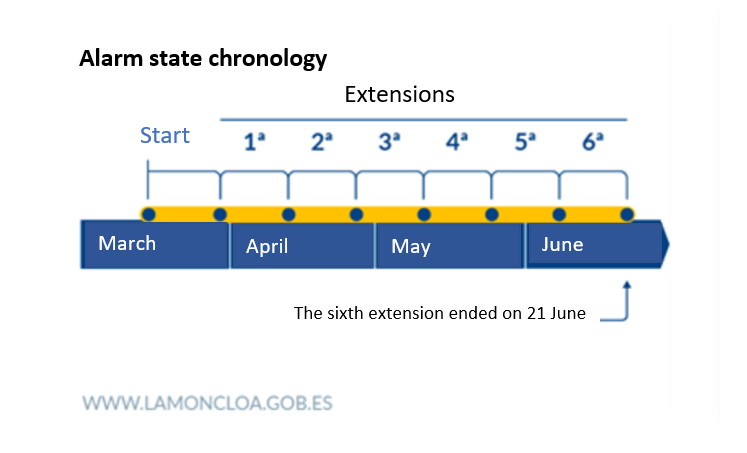
Quarantine, restriction of movements and cancellation of economic and educational activities
On March 13, the proclamation of the state of alarm was accompanied by the nationwide curfew by which people was prohibited to go outside home, including walks and outdoor sports, with the only exception of essential activities such as the purchase of food or medication or visits to the doctor.
Although the quarantine was initially provided to last until beginning of April, on April 4 President Pedro Sánchez announced that the curfew should be extended. Finally, after various prorogations, the lockdown lasted until beginning of May, when partial departures were allowed.
The prohibition of movements inside the country between different regions has also been accompanied by the restriction of international movements. The first measure on this respect, adopted on March 10, ordered the immediate deletion of all direct flights from Italy -as it was the European country most affected by the virus in that moment-. Suddenly, following the national quarantine, national and international flights were seriously restricted - regardless of the country of origin or destination-, only allowing those realized for forced and justified causes.
Employees and the self-employed were initially allowed to drive to work. However, all presential working activities were finally suspended -with few essential exceptions-, requiring in this way working from home if possible. Cessation of majority of economic activities have had serious consequences for many companies and individual workers, reflection in the great increase of layoffs as well as the great reduction of companies’ benefits or workers’ salaries.
Schools and universities across the country were initially closed for about two weeks after the President Pedro Sánchez translated on March 15 to the autonomic governments -with the competencies over education- the recommendation of closing every centre. The measure was prolongated, suspending presential classes indefinitely as a consequence of the declaration of the national quarantine. However, duration of the course has not been altered, continuing education activities through online media. Following proposals by the State School Council (CEE) -the highest advisory body on educational matters-, which rejected a general pass -as applied in the case of Italy-, the "general rule" for evaluating under this extraordinary conditions has been to take into account performance on previous semesters and failing only when strictly necessary. [13]
These restrictions have been accompanied by closure of most locals and cancellation of most activities. Locals, restaurants, hotels, sport centres, cultural spaces, etc. were closed and the celebration of sport and cultural events cancelled (art. 10, Real Decreto 463/2020, March 14).
Restrictive measures as the closure of schools and universities were also taken (with some particularities) in most European countries as Switzerland-one of the first countries applying these kinds of drastic measures, already at the end of February-. On the opposite side we found the case of Sweden, where schools, restaurants, etc. did not have to close. In comparison with other European countries, the Spanish quarantine have been one of the strictest. While in other countries like Italy and France -where the national lockdown was also declared- regulated activities in the outside still allowed, in countries like Netherlands, Sweden, Switzerland, Norway or Belgium, there were only soft-lockdowns or no mandatory lockdown at all, with few restrictions and trying to appeal in a greater extent to the “citizens responsibility”. Also, the Spanish quarantine, together with that of Italy, France and Portugal, had been one of highest lengths.
Economic impact of measures
These measures have had a great impact for the Spanish economy -greater than in most countries- due to the severity of its containment measures and its greater dependence on sectors especially affected by the pandemic, such as tourism or services.
The OECD estimates that Spanish GDP has sunk 23.3% since the start of the crisis, a much worse figure than that of the rest of the Eurozone where the fall has been 18.4% or that of the OECD, whose fall it is 14.7%. In addition, economic previsions for the future are even more worrying: according to the IMF, in 2021 Spanish GDP will fall by 12.8% -a figure that exceeds the average drop forecast for the euro area, of 10.2%, and the 4.9% estimated for the planet as a whole-. The figure represents an unprecedented decline since the Civil War and places the Spanish economy as one of the most affected by the pandemic, along with that of Italy, where a similar decline is expected. [14]
Although the quarantine was initially provided to last until beginning of April, on April 4 President Pedro Sánchez announced that the curfew should be extended. Finally, after various prorogations, the lockdown lasted until beginning of May, when partial departures were allowed.
The prohibition of movements inside the country between different regions has also been accompanied by the restriction of international movements. The first measure on this respect, adopted on March 10, ordered the immediate deletion of all direct flights from Italy -as it was the European country most affected by the virus in that moment-. Suddenly, following the national quarantine, national and international flights were seriously restricted - regardless of the country of origin or destination-, only allowing those realized for forced and justified causes.
Employees and the self-employed were initially allowed to drive to work. However, all presential working activities were finally suspended -with few essential exceptions-, requiring in this way working from home if possible. Cessation of majority of economic activities have had serious consequences for many companies and individual workers, reflection in the great increase of layoffs as well as the great reduction of companies’ benefits or workers’ salaries.
Schools and universities across the country were initially closed for about two weeks after the President Pedro Sánchez translated on March 15 to the autonomic governments -with the competencies over education- the recommendation of closing every centre. The measure was prolongated, suspending presential classes indefinitely as a consequence of the declaration of the national quarantine. However, duration of the course has not been altered, continuing education activities through online media. Following proposals by the State School Council (CEE) -the highest advisory body on educational matters-, which rejected a general pass -as applied in the case of Italy-, the "general rule" for evaluating under this extraordinary conditions has been to take into account performance on previous semesters and failing only when strictly necessary. [13]
These restrictions have been accompanied by closure of most locals and cancellation of most activities. Locals, restaurants, hotels, sport centres, cultural spaces, etc. were closed and the celebration of sport and cultural events cancelled (art. 10, Real Decreto 463/2020, March 14).
Restrictive measures as the closure of schools and universities were also taken (with some particularities) in most European countries as Switzerland-one of the first countries applying these kinds of drastic measures, already at the end of February-. On the opposite side we found the case of Sweden, where schools, restaurants, etc. did not have to close. In comparison with other European countries, the Spanish quarantine have been one of the strictest. While in other countries like Italy and France -where the national lockdown was also declared- regulated activities in the outside still allowed, in countries like Netherlands, Sweden, Switzerland, Norway or Belgium, there were only soft-lockdowns or no mandatory lockdown at all, with few restrictions and trying to appeal in a greater extent to the “citizens responsibility”. Also, the Spanish quarantine, together with that of Italy, France and Portugal, had been one of highest lengths.
Economic impact of measures
These measures have had a great impact for the Spanish economy -greater than in most countries- due to the severity of its containment measures and its greater dependence on sectors especially affected by the pandemic, such as tourism or services.
The OECD estimates that Spanish GDP has sunk 23.3% since the start of the crisis, a much worse figure than that of the rest of the Eurozone where the fall has been 18.4% or that of the OECD, whose fall it is 14.7%. In addition, economic previsions for the future are even more worrying: according to the IMF, in 2021 Spanish GDP will fall by 12.8% -a figure that exceeds the average drop forecast for the euro area, of 10.2%, and the 4.9% estimated for the planet as a whole-. The figure represents an unprecedented decline since the Civil War and places the Spanish economy as one of the most affected by the pandemic, along with that of Italy, where a similar decline is expected. [14]
Sanitary system
The Spanish sanitary system suffered a huge collapse: as the number of patients hospitalized and admitted to the ICU increased, the distance between each community's infection curve and its ceiling on healthcare resources narrowed. Indeed, due to saturation in regions like Madrid, intensive care beds were no longer occupied according to the severity of the patient, but rather according to their age and life expectancy [15] .
The terrible consequences of sanitary collapse are patent if we compare the number of deaths of Spain or its neighbour, France -where the sanitary collapse also lead to high death figures- with Germany, where -although the number of infections was also high- the higher health resources and anitary capacity -among other factors- lead to lower mortality.
The lack of resources as masks also for the health personnel has been related with the high proportion of infected sanitary team, unduly protected. On April 11, 2020, the government said 25,000 medical professionals in Spain had become infected. According to trade unions, the country presents an infection rate of 14%, the highest in Europe during the pandemic. [16]
Different measures were adopted with the purpose of reinforcing the health system: [17]
The terrible consequences of sanitary collapse are patent if we compare the number of deaths of Spain or its neighbour, France -where the sanitary collapse also lead to high death figures- with Germany, where -although the number of infections was also high- the higher health resources and anitary capacity -among other factors- lead to lower mortality.
The lack of resources as masks also for the health personnel has been related with the high proportion of infected sanitary team, unduly protected. On April 11, 2020, the government said 25,000 medical professionals in Spain had become infected. According to trade unions, the country presents an infection rate of 14%, the highest in Europe during the pandemic. [16]
Different measures were adopted with the purpose of reinforcing the health system: [17]
- The resources of the Ministry of Health were reinforced through a contingency fund of 1,000 million euros (art. 1, Real Decreto-ley 7/2020) to which it was added an advance of 2,800 million euros of payments on account to the Autonomous Communities to reinforce their local health systems (arts. 2-6, Real Decreto-ley 7/2020).
- The procedure for contracting needed goods or services is streamlined and accelerated (art. 16, Real Decreto-ley 7/2020).
- The Government is empowered to regulate the prices of some products needed for protection, as masks (art. 7, Real Decreto-ley 7/2020).
- Extraordinary credits were provided to the Higher Council for Scientific Research and the Carlos III Health Institute (art. 37, Real Decreto-ley 8/2020).
- As in other countries like Bulgaria -where a temporary emergency hospital was created-, further spaces were enabled for the attention of affected people: the fair space IFEMA was converted into a field hospital, an option that was followed by most communities in view of the increase in the number of new daily positives. Also, in face of the huge amount of deaths, on March 23, 2020, it was also announced that the Madrid Ice Palace had been converted into a temporary mortuary.
- The sanitary collapse has also forced the Health Department to call retired health workers and students: 50,000 professionals, including MIR residents, retired doctors and nurses, and final year students of both careers. [18]
Masks
Masks, together with gloves, are the basic protective equipment more demanded for protecting against the virus. Difficulties for acquiring these material -because of the great international collapse of this market-, have been acompanied by interesting scandals in Spain: the Spanish government bought 2.1 million Garry Galaxy masks from the Chinese supplier Hangzhou Ruining Trading -as part of a larger batch of 8.8 million FFP2 masks- for a value of 31.2 million euros, as an attemp to alleviate the shortage of equipment. However, many of those masks were of a poor quality. Although the Health Department requested their immediate withdrawal, sanitary professionals used them for about 10 days. As a result, more than a thousand health workers had to be isolated and tested for SARS-CoV-2 after being exposed by using these defective masks.
From recommended to compulsory use
The official discourse regarding the use of masks have been variant and sometimes contradicting, causing confusion among population. The World Health Organization (WHO) itself came to advise against its use in the general population, due to shortages in hospitals and health centres. Thus, the use of masks in Spain was initially mandatory exclusively in public transport (since May 4) and only recommended in other spaces. However, as more masks and other resources became available and in front of the evidence of their utility, the discourse radically changed in the country: on 21 May a new Ministerial Order stated the compulsory use of masks by persons over the age of six in all enclosed public spaces -including public transport, planes or private vehicles whose occupants do not live in the same house- and in outdoors spaces when the safety distance of two metres cannot be guaranteed. Despite the recent relief from some measures stablished during the state of alarm, Health Minister Salvador Illa announced on Tuesday 9 June that the use of masks is still compulsory. [19] This strict measures of usage contrast with that of Germany, Netherlands, France, Italy or Portugal -where only is compulsory in the public transport or other public spaces- and even more with that of Norway, the UK, Sweden and Switzerland -where the use of masks is not required at any place-.
Regulation of prices
As a response to the great increase on the price of products like masks and hydroalcoholic gels -caused by the unprecendent demand of these products-. on 23rd April, the Ministry of Health established a cealling price for these products in order to guarantee citizens access to them under non-abusive economic conditions. The surgical masks had a maximum price of 0.96 euros and the gels and hydroalcoholic solutions, between 0.015 euros and 0.021 euros per millilitre. [20]
The performance of the Community of Madrid stands out in front of the rests of communities for their pioneer action providing masks type FPP2 among their autonomic population for free. On 11th May the Madrid government started to distribute seven million reusable masks KN95 FPP2 free of charge to their population. To obtain a free mask, the inhabitants of the region must present their health card at any pharmacy or, if they belong to the group of mutualist officials, their DNI or NIE. [21]
From recommended to compulsory use
The official discourse regarding the use of masks have been variant and sometimes contradicting, causing confusion among population. The World Health Organization (WHO) itself came to advise against its use in the general population, due to shortages in hospitals and health centres. Thus, the use of masks in Spain was initially mandatory exclusively in public transport (since May 4) and only recommended in other spaces. However, as more masks and other resources became available and in front of the evidence of their utility, the discourse radically changed in the country: on 21 May a new Ministerial Order stated the compulsory use of masks by persons over the age of six in all enclosed public spaces -including public transport, planes or private vehicles whose occupants do not live in the same house- and in outdoors spaces when the safety distance of two metres cannot be guaranteed. Despite the recent relief from some measures stablished during the state of alarm, Health Minister Salvador Illa announced on Tuesday 9 June that the use of masks is still compulsory. [19] This strict measures of usage contrast with that of Germany, Netherlands, France, Italy or Portugal -where only is compulsory in the public transport or other public spaces- and even more with that of Norway, the UK, Sweden and Switzerland -where the use of masks is not required at any place-.
Regulation of prices
As a response to the great increase on the price of products like masks and hydroalcoholic gels -caused by the unprecendent demand of these products-. on 23rd April, the Ministry of Health established a cealling price for these products in order to guarantee citizens access to them under non-abusive economic conditions. The surgical masks had a maximum price of 0.96 euros and the gels and hydroalcoholic solutions, between 0.015 euros and 0.021 euros per millilitre. [20]
The performance of the Community of Madrid stands out in front of the rests of communities for their pioneer action providing masks type FPP2 among their autonomic population for free. On 11th May the Madrid government started to distribute seven million reusable masks KN95 FPP2 free of charge to their population. To obtain a free mask, the inhabitants of the region must present their health card at any pharmacy or, if they belong to the group of mutualist officials, their DNI or NIE. [21]
Economic measures
The great consequences of the pandemic on public health of the country were suddenly expanded to almost every aspect of society, including the economy, mainly because of the forced temporary-closure of many companies and the temporary cessed of many working-activities, among others. To face this challnge, the Spanish government has adopted various measures to support collectivises and more vulnerable and more economically affected, as for example, the creation of a state funded program with 300 million euros to guarantee the home assistance of dependent people (art. 1, Real Decreto-ley 8/2020). Also, the government has adopted measures to make the economy more flexible, preserve employment and support workers: [22]
- Companies are facilitated to enable remote work (art. 5, Real Decreto-ley 8/2020).
- An extraordinary benefit is approved for cessation of activity for the self-employed (art. 17, Real Decreto-ley 8/2020).
- Amplification of the conditions for getting access to benefits for workers while exemptions are foreseen in social contributions (arts. 23-28, Real Decreto-ley 6/2020).
- Simplification of the procedures for temporal adjustment of employment -ERTEs in Spanish- (art. 22, Real Decreto-ley 8/2020).
- Support measures for SMEs to boost their adaptation to the digital environment through the program “Acelera”, endowed with 250 million euros (Disposición adicional 8ª y Anexo, Real Decreto-ley 8/2020).
Plan towards the "new normality"
With the implementation of the national quarantine and other measures, relieving the hardness of restrictions and “going back to normality” is still being a difficult task for the country as the threat of new sprouts is persistent. Following the example of France or Portugal -where plans with different progressive phases were designed-, in Spain, new measures allowing again further degree of freedom have come progressively through a plan composed by differentiated phases on the path towards what has been called “new normality”. This plan, presented on April 28, considers and examines separatedly and individually each Spanish region so the government can decide if it is allowed or not to pass to the next phase -based on the sanitary and epidemiological situation of each area, among other criteria-. Each of the four phases will have a minimum duration of 2 weeks and maximum of 8 weeks. [23]
As a first step, since April 26, children accompanied by a parent were allowed to leave the house for maximum one hour within a radius of one kilometre. Suddenly, from May 2, adults were also allowed to go outside -after a curfew of eight weeks- also for one hour within specified times (8:00 a.m. - 10:00 a.m. and 8:00 p.m. - 11:00 p.m.) and within a radius of one kilometre too.
The Phase 1 [24] came into force on May 4. Besides the exit of children, family walks and individual sport activities, this phase includes the aperture of some locals for the individual attention of clients with previous date (for example hairdressers or food delivery restaurants). On May 11 most regions of the country entered on the Phase 1. However, the Community of Madrid remained on the Phase 0 despite their request for moving to the next phase.
As a first step, since April 26, children accompanied by a parent were allowed to leave the house for maximum one hour within a radius of one kilometre. Suddenly, from May 2, adults were also allowed to go outside -after a curfew of eight weeks- also for one hour within specified times (8:00 a.m. - 10:00 a.m. and 8:00 p.m. - 11:00 p.m.) and within a radius of one kilometre too.
The Phase 1 [24] came into force on May 4. Besides the exit of children, family walks and individual sport activities, this phase includes the aperture of some locals for the individual attention of clients with previous date (for example hairdressers or food delivery restaurants). On May 11 most regions of the country entered on the Phase 1. However, the Community of Madrid remained on the Phase 0 despite their request for moving to the next phase.
- Possibility of contact between small groups of people without previous pathologies and who are not vulnerable (10 people). In this phase, small shops
- Small shops are allowed to reopen with a limited capacity of 30% and a minimum distance of 2 meters between customers. A preferential service schedule is established for people over 65 years of age.
- For restaurants and bars, they are allowed to open terraces also at 30% of their capacity.
- Hotels are also allowed to reopen.
- Resumption of agri-food activity that had been stopped.
- Cultural acts and shows of less than 30 people can be held indoors (with a third capacity) and less than 200 people outdoors. Also, visits to museums limited to one-third capacity are allowed.
- Social contact is allowed in larger groups (15 people).
- Travel to second homes is allowed, but only when they are in the same province
- Capacity of shops is increased to 40% and shopping centres may reopen to the public.
- In restaurants and bars, consumption is allowed within the premises, respecting the separation between customers.
- Cinemas, theatres and auditoriums are reopened with a capacity limited to one third. Cultural shows such as concerts can be held with a third capacity indoors and up to 400 people outdoors.
- The limitation of capacity in shops, restaurants or bars is increased to 50% and the prohibition to use the common areas and recreational areas of shopping centres is lifted.
- Clubs and night bars can be reopened with a maximum capacity of one third of the usual.
- Opening of beaches in safety and distance conditions

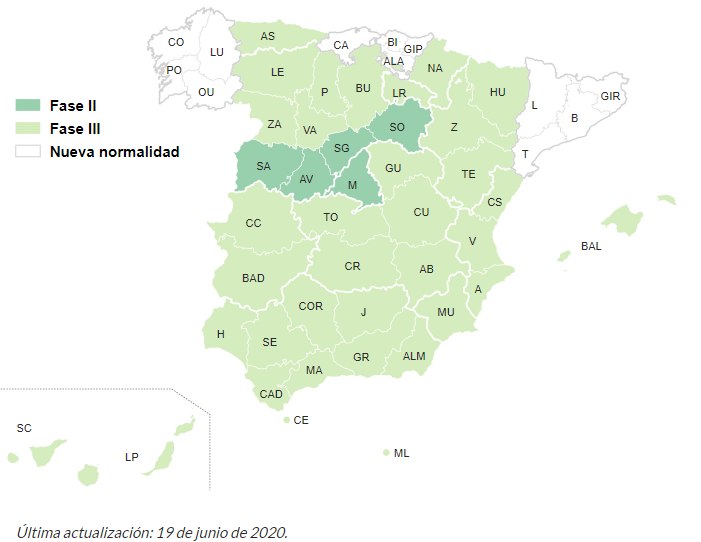
Coordination between Autonomous Communities
Collaboration between Administrations is working at three levels: the Health Minister Salvador Illa is in contact with the Regional Health Advisors in the Inter-Territorial Health Council; the Government Delegate in each autonomy is in contact with the Civil Protection Advisor and the Mayors; and finally, the Regional Presidents are in contact with the Ministers of Health and Finance and other members of the Government.
At the beginning of the crisis, health decentralization became a problem. Each community adopted its own measures while the central government's task was limited to providing public health recommendations. The reality is that the Ministry of Health is a small minsitry with very limited powers due to the decentralization of health competencies on the Communities, a fact that was evidenciated when it was unable to take charge of hiring the medical equipment and the Ministry of Finance has had to take on this task. This led to confusion and lack of consensus on action protocols, and in the end, to great interterritorial differences: each community proposed its own measures and plans -experiencing very different speeds regarding training of professionals or actions protocols- and created different technical committees, advisory groups, etc.
However, latter declaration of the state of alarm -which temporarily alters the order of distribution of competences established in the constitutional and statutory order-, led to the temporary centralisation of the autonomous competences in order to ensure that decisions on the key protocols were taken throughout the country at the same time. Nevertheless, this does not prevent implementation, including the adoption of complementary measures, from being carried out by the competent authorities. The Royal Decree declaring the state of alert does not exclude the participation of the Autonomous Communities (and local authorities) in the adoption of the measures and in the management of the crisis.
The great centralization and the homogeneity in measures for the entire nation is really interesting specially in light of huge differences in the figures -both of infections and deaths- of the different Autonomic Communities. While in other federal countries like Germany and the United States the different landers or states -with higher autonomy to the implementation of measures in this crisis in comparison with Spanish Communities- adopted different measures, the lack of coordination at first, on the one hand, and the homogeneity and great centralization of the Spanish response, on the other hand, seem to indicate that the Autonomic model is still a issue for the country.
At the beginning of the crisis, health decentralization became a problem. Each community adopted its own measures while the central government's task was limited to providing public health recommendations. The reality is that the Ministry of Health is a small minsitry with very limited powers due to the decentralization of health competencies on the Communities, a fact that was evidenciated when it was unable to take charge of hiring the medical equipment and the Ministry of Finance has had to take on this task. This led to confusion and lack of consensus on action protocols, and in the end, to great interterritorial differences: each community proposed its own measures and plans -experiencing very different speeds regarding training of professionals or actions protocols- and created different technical committees, advisory groups, etc.
However, latter declaration of the state of alarm -which temporarily alters the order of distribution of competences established in the constitutional and statutory order-, led to the temporary centralisation of the autonomous competences in order to ensure that decisions on the key protocols were taken throughout the country at the same time. Nevertheless, this does not prevent implementation, including the adoption of complementary measures, from being carried out by the competent authorities. The Royal Decree declaring the state of alert does not exclude the participation of the Autonomous Communities (and local authorities) in the adoption of the measures and in the management of the crisis.
The great centralization and the homogeneity in measures for the entire nation is really interesting specially in light of huge differences in the figures -both of infections and deaths- of the different Autonomic Communities. While in other federal countries like Germany and the United States the different landers or states -with higher autonomy to the implementation of measures in this crisis in comparison with Spanish Communities- adopted different measures, the lack of coordination at first, on the one hand, and the homogeneity and great centralization of the Spanish response, on the other hand, seem to indicate that the Autonomic model is still a issue for the country.
Legitimacy
The Spanish case is characterised by its unique political tension. Despite in most countries political parties have reduced confrontation in front of necessity of unity and joint efforts -as in the case of Spanish neighbour Portugal, that had stand out by the support the opposition provided to the government-, in Spain political parties have not made such concessions. Indeed, the present crisis seem to have deepened the gap between the leftist coalition government of PSOE and Podemos and the right opposition headed by PP and followed by the new far-right party Vox. PP and VOX have accused the government of lack of prevision, inadequate economic measures, lying about the death’s figures, hiding information with partisan ends, and incidents in the buying of sanitary material. [27]
Although Sánchez proposed a reedition of the “Moncloa Pacts” -founding text of the Spanish transition- to face together the reconstruction of the country, the opposition have rejected the proposition. This lack of trust and unity between Spanish parties have also been evidenced in state of alarm's prolongations votings, where progressive reduction of support made more difficult to approve this measure each time. For example, in the voting for the fifth prolongation 162 deputies from PP, Vox, Compromís and Catalan independentist parties voted against the extension. [28]
Nevertheless, government problems not only come from the political sphere but also from the citizenry. Although public opinion about Pedro Sánchez seems to have been moderately improved, the public opinion about the government has clearly get worse since the start of the pandemic. One of the most relevant and polemic issues that have damaged the image of the government and has been used to protest against it was the celebration of national demonstrations on Mars 8 for the International Women’s Day. The government has been blamed for not cancelling the act in front of the risk of the propagation of the virus.
According to a survey elaborated by the Newspaper “Público” and the foundation “En Acción” in collaboration with “Sináptica” [29] -held online between 28 April and 4 May to 1.001 participants from different Spanish regions and above 18- one in four respondents consider the general management of the coronavirus by the Government "bad" and one in three rate it as "very bad” (negative opinions account for a 59% in front of positive ones that only accounts for a 35%), an interesting point in face of public responses in other countries, like Bulgaria and Netherlands, where support for government management seems to have been much more positive. However, it is important to highlight that there are significant partisan differences regarding public opinion, as we can se on the graph below.
Although Sánchez proposed a reedition of the “Moncloa Pacts” -founding text of the Spanish transition- to face together the reconstruction of the country, the opposition have rejected the proposition. This lack of trust and unity between Spanish parties have also been evidenced in state of alarm's prolongations votings, where progressive reduction of support made more difficult to approve this measure each time. For example, in the voting for the fifth prolongation 162 deputies from PP, Vox, Compromís and Catalan independentist parties voted against the extension. [28]
Nevertheless, government problems not only come from the political sphere but also from the citizenry. Although public opinion about Pedro Sánchez seems to have been moderately improved, the public opinion about the government has clearly get worse since the start of the pandemic. One of the most relevant and polemic issues that have damaged the image of the government and has been used to protest against it was the celebration of national demonstrations on Mars 8 for the International Women’s Day. The government has been blamed for not cancelling the act in front of the risk of the propagation of the virus.
According to a survey elaborated by the Newspaper “Público” and the foundation “En Acción” in collaboration with “Sináptica” [29] -held online between 28 April and 4 May to 1.001 participants from different Spanish regions and above 18- one in four respondents consider the general management of the coronavirus by the Government "bad" and one in three rate it as "very bad” (negative opinions account for a 59% in front of positive ones that only accounts for a 35%), an interesting point in face of public responses in other countries, like Bulgaria and Netherlands, where support for government management seems to have been much more positive. However, it is important to highlight that there are significant partisan differences regarding public opinion, as we can se on the graph below.
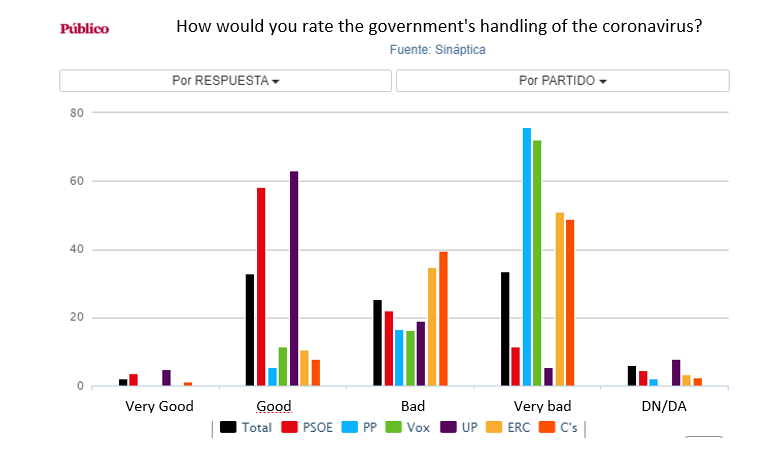
Nevertheless, despite the generalization of public dissatisfaction with Governments management, there is a measure that stands above the others regarding the consensus and support generated around it: the restriction of mobility.
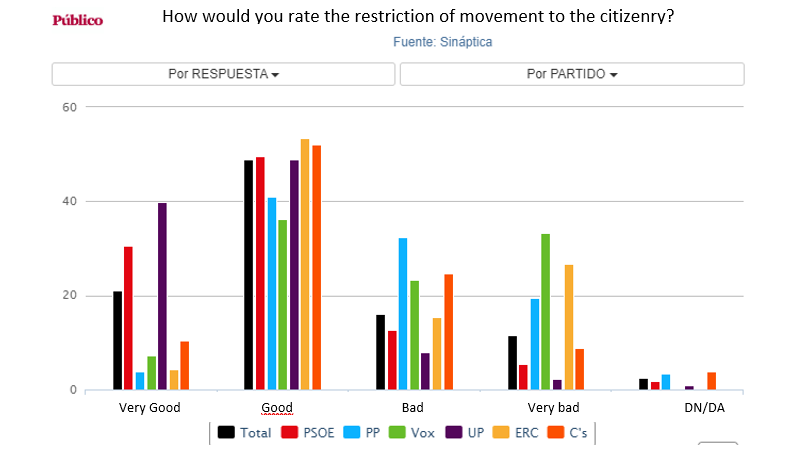
People disconformity has been reflected in the multiple protests that took place in the country, specially during the month of April. To the casseroles from the balconies as a sign of protest against the government, protesters added demonstrations on the streets -despite its prohibition because of security measures-. The demonstrations that started in wealthy neighbourhoods of Madrid, were expanded to the rest of the country. The most relevant demonstration took place in front of the PSOE headquarters in Madrid street Ferraz, where hundreds of people -approximately 450 according to Efe agency [30] -have come to ask for the resignation of the president. These acts also included “scratches” to some government members as José Luis Ábalos and Pablo Iglesias [31] Also, due to accusations of skipping security measures, the far-right party VOX called for demonstrations from cars in approximately 50 different cities, including Barcelona, Sevilla, Málaga, Valencia, Córdoba or Bilbao. The act, that took place on April 23, attracted miles of people that blocked several avenues with their cars. In Madrid, an estimated 6000 vehicles attended the protest. [32]
Overall evaluation
Evaluating the actuation of the Spanish government regarding present crisis caused by COVID-19 is still a difficult task as the pandemic still supposes new challenges to every government all around the world. There are further important decisions to be made in the future that will determine how this crisis will unfold and end. However, considering the measures taken by the Spanish government until the present some observations could be made.
The first key aspect that must be considered is the great number of infected cases and deaths in the country in comparison with the rest of the world -being in a significant position in world rankings-, but specially in comparison with the rest of Europe, where in general the other countries seem to have performed better as they have suffered a lower impact of the crisis, both in sanitary and economic terms.
The disaster lived in Spain seem to indicate a bad or at least insufficient management of the crisis. Errors started in the first stages of the crisis due to the lack of initial responsiveness to the crisis. Indeed, errors can be placed even before the start of the pandemic by considering previous maintenance of the Spanish sanitary system, considerably weak -because of lack of capacity and resources to confront a health emergency of these measures-. However, the state of the sanitary system alone cannot be considered as the main cause of Spanish failure. The sanitary limitations to ensure proper contention of the virus -dealing with great amount of patients-, could have been compensated or substituted by greater and earlier anticipation as well as ealier decision-making (adopting needed measures when the first clues appeared) around an strategy cantered on early detention, trying to hold back further spread of the virus at the very beginning. Indeed, other European countries with a similar sanitary situation -as for example Portugal, with a similar GDP proportion of healthcare expedienture and amount of hospital beds per 1.000 inhabitants- didn’t experienced similar catastrophic results probably because they succesfully adopted main measures much more rapidly. Thus, this fact that clearly indicates that problems in Spain went further beyond sanitary conditions.
Then, one of the main aspects we can highlight at the roots of Spanish unsuccessful management of the crisis is its late response. Although there was already a very complete pandemic plan since 2005, the measures indicated on it were not implemented at the necessary time. While other European countries taken only few days from the start of the pandemic on their respective countries -so the number of cases on the moment when measures were adopted was not so dramatical-, in Spain, same measures took longer to be adopted -when the number of cases was already really alarming-. It is very significant that while other countries like Portugal, Hungary or the Check Republic started to adopt measures from 1 to 4 days -or even before- first cases were detected, in Spain frontiers were not closed and movements were not limited after nearly 15 days and the closure of non-essential production after 27 days [33]
It is true that in other European countries the virus entered later -that is, first infection cases started to appear later- and then they have more time to react and, most importantly, the previous experience of other countries as examples. However, we cannot hide the fact that Spain already had significant clues and reasons, like the situation in China or in Italy as well as the warnings from some experts, that could have been considered as significant to have implemented 2005 pandemic plan’s previsions much earlier to avoid in this way the great exponential growth of cases in the country.
Focusing on measures we can notice that the lack of prevision and effective preventive measures on the first stages of the crisis, have been “compensated” or substituted by the great hardness and restrictiveness of subsequent measures in order to impede further exponential growth. In comparison with other European countries, Spain has been one of the countries in which civil liberties had been limited in a greater extent. Spanish quarantine has been one of the hardest in Europe, regarding both its length and restrictiveness: while in other countries some walks or outside activities were allowed, in Spain, every outside movements have been prohibited for months. This is a key point when analysing the future situation of the country: although the strict measures appear to have been effective in their task of greatly reducing the exponential growth of the virus, the cessation and limitations of majority of working activities for so long -as required by that strict measures-, specially regarding tourism and the service sector -of which the country is very dependent- have had (and still will have) serious economic consequences for the entire country, with a decline of Spanish GDP of nearly a 13% -as estimated by the IMF-.
Further problems on crisis management had also come from lack of the necessary coordination between Autonomous Communities - a problem that has contributed to the already controversial debate about the properness of the current form of territorial organization of the country. Both the initial lack of power and experience of the central health ministry to manage the crisis as well as the great initial disparities on the procedures applied by each territory and the lack of coordination, have made evident some of the gaps of current organizational model. The great centralization applied by the central government to manage the crisis -centralizing all the competences on the central government and applying the same measures for the entire territory- nor only seems contradictory with respect to the decentralized system of the country but also it seems surprising when we compare it with other federal countries, like Germany or the USA, were no such measures where adopted: decentralization model was not affected and each region or federal entity applied different measures. In Spain, the reflection of those who are experiencing the crisis and of external observers is that the collaboration mechanisms of the territories with the central government must be strengthened.
These problems have been accompanied and aggravated by great tensions both in the political and the public sphere. On the one hand, critics from the opposition and the citizenry can be seen as a logic and even positive response as it forms part of the democratic exercise of government accountability, punishing country’s leaders for their bad management of the crisis. However, on the other hand, the lack legitimacy and unity that have predominated in other European countries could suppose a great problem for Spanish government, making more difficult to still managing this crisis in following months -when new sprouts are expected to happen- as they will lack the needed legitimacy for implementing the necessary measures in the future.
The first key aspect that must be considered is the great number of infected cases and deaths in the country in comparison with the rest of the world -being in a significant position in world rankings-, but specially in comparison with the rest of Europe, where in general the other countries seem to have performed better as they have suffered a lower impact of the crisis, both in sanitary and economic terms.
The disaster lived in Spain seem to indicate a bad or at least insufficient management of the crisis. Errors started in the first stages of the crisis due to the lack of initial responsiveness to the crisis. Indeed, errors can be placed even before the start of the pandemic by considering previous maintenance of the Spanish sanitary system, considerably weak -because of lack of capacity and resources to confront a health emergency of these measures-. However, the state of the sanitary system alone cannot be considered as the main cause of Spanish failure. The sanitary limitations to ensure proper contention of the virus -dealing with great amount of patients-, could have been compensated or substituted by greater and earlier anticipation as well as ealier decision-making (adopting needed measures when the first clues appeared) around an strategy cantered on early detention, trying to hold back further spread of the virus at the very beginning. Indeed, other European countries with a similar sanitary situation -as for example Portugal, with a similar GDP proportion of healthcare expedienture and amount of hospital beds per 1.000 inhabitants- didn’t experienced similar catastrophic results probably because they succesfully adopted main measures much more rapidly. Thus, this fact that clearly indicates that problems in Spain went further beyond sanitary conditions.
Then, one of the main aspects we can highlight at the roots of Spanish unsuccessful management of the crisis is its late response. Although there was already a very complete pandemic plan since 2005, the measures indicated on it were not implemented at the necessary time. While other European countries taken only few days from the start of the pandemic on their respective countries -so the number of cases on the moment when measures were adopted was not so dramatical-, in Spain, same measures took longer to be adopted -when the number of cases was already really alarming-. It is very significant that while other countries like Portugal, Hungary or the Check Republic started to adopt measures from 1 to 4 days -or even before- first cases were detected, in Spain frontiers were not closed and movements were not limited after nearly 15 days and the closure of non-essential production after 27 days [33]
It is true that in other European countries the virus entered later -that is, first infection cases started to appear later- and then they have more time to react and, most importantly, the previous experience of other countries as examples. However, we cannot hide the fact that Spain already had significant clues and reasons, like the situation in China or in Italy as well as the warnings from some experts, that could have been considered as significant to have implemented 2005 pandemic plan’s previsions much earlier to avoid in this way the great exponential growth of cases in the country.
Focusing on measures we can notice that the lack of prevision and effective preventive measures on the first stages of the crisis, have been “compensated” or substituted by the great hardness and restrictiveness of subsequent measures in order to impede further exponential growth. In comparison with other European countries, Spain has been one of the countries in which civil liberties had been limited in a greater extent. Spanish quarantine has been one of the hardest in Europe, regarding both its length and restrictiveness: while in other countries some walks or outside activities were allowed, in Spain, every outside movements have been prohibited for months. This is a key point when analysing the future situation of the country: although the strict measures appear to have been effective in their task of greatly reducing the exponential growth of the virus, the cessation and limitations of majority of working activities for so long -as required by that strict measures-, specially regarding tourism and the service sector -of which the country is very dependent- have had (and still will have) serious economic consequences for the entire country, with a decline of Spanish GDP of nearly a 13% -as estimated by the IMF-.
Further problems on crisis management had also come from lack of the necessary coordination between Autonomous Communities - a problem that has contributed to the already controversial debate about the properness of the current form of territorial organization of the country. Both the initial lack of power and experience of the central health ministry to manage the crisis as well as the great initial disparities on the procedures applied by each territory and the lack of coordination, have made evident some of the gaps of current organizational model. The great centralization applied by the central government to manage the crisis -centralizing all the competences on the central government and applying the same measures for the entire territory- nor only seems contradictory with respect to the decentralized system of the country but also it seems surprising when we compare it with other federal countries, like Germany or the USA, were no such measures where adopted: decentralization model was not affected and each region or federal entity applied different measures. In Spain, the reflection of those who are experiencing the crisis and of external observers is that the collaboration mechanisms of the territories with the central government must be strengthened.
These problems have been accompanied and aggravated by great tensions both in the political and the public sphere. On the one hand, critics from the opposition and the citizenry can be seen as a logic and even positive response as it forms part of the democratic exercise of government accountability, punishing country’s leaders for their bad management of the crisis. However, on the other hand, the lack legitimacy and unity that have predominated in other European countries could suppose a great problem for Spanish government, making more difficult to still managing this crisis in following months -when new sprouts are expected to happen- as they will lack the needed legitimacy for implementing the necessary measures in the future.
Country's favourite stay at home song
This beautiful song from the Spanish group “Vetusta Morla” was made in collaboration with other famous Spanish singers as a tribute to the sanitary professionals and all the people that have contributed to the common societal effort of facing this crisis. The benefits generated by this song are being donated to the Superior Council of Scientific Investigations (CSIC) in order to contribute to the investigation of the SARS-CoV-2.
[1] Ministry of Health, Consumption and Social Welfare https://www.mscbs.gob.es/ciudadanos/enfLesiones/enfTransmisibles/pandemia/home.htm accessed 05/07/2020
[2] OECD https://www.oecd.org/spain/Espa%C3%B1a-Perfil-sanitario-nacional-2019-Launch-presentation.pdf accessed 05/07/2020
[3] OECD https://data.oecd.org/healtheqt/hospital-beds.htm accessed 06/07/2020
[4] Ministry of Health https://www.mscbs.gob.es/profesionales/saludPublica/ccayes/alertasActual/nCov-China/documentos/Actualizacion_150_COVID-19.pdf accessed 15/06/2020
[5] ESRI España https://experience.arcgis.com/experience/50d6c4c5599a43f4bebf517daa3a97b6 accessed 15/06/2020
[6] Ministry of Health https://www.mscbs.gob.es/profesionales/saludPublica/ccayes/alertasActual/nCov-China/documentos/COVID19_Estrategia_vigilancia_y_control_e_indicadores.pdf accessed 17/06/2020
[7] The World Economic Forum COVID Action Platform https://www.weforum.org/agenda/2020/04/these-are-the-oecd-countries-testing-most-for-covid-19/ accessed 17/06/2020
[8] El País https://elpais.com/sociedad/2020/05/27/actualidad/1590570927_371193.html accessed 16/06/2020
[9] BOE https://www.boe.es/eli/es/rdl/2020/03/12/7/con
[10] BOE https://www.boe.es/buscar/act.php?id=BOE-A-2020-3824 accessed 05/06/2020
[11] BOE https://www.boe.es/eli/es/rd/2020/03/14/463/con accessed 05/06/2020
[12] Presidency of the Government https://www.lamoncloa.gob.es/covid-19/Paginas/estado-de-alarma.aspx
[13] El Confidencial https://www.elconfidencial.com/espana/2020-04-15/final-curso-colegios-universidades-coronavirus_2549620/ accessed 05/06/2020
[14] El País https://cincodias.elpais.com/cincodias/2020/06/24/economia/1592996411_001401.html#:~:text=Crisis%20del%20coronavirus-,El%20FMI%20eleva%20la%20ca%C3%ADda%20del%20PIB%20espa%C3%B1ol%20en%202020,12%2C8%25%20tras%20el%20confinamiento accessed 10/06/2020
[15] El Confidencial https://www.elconfidencial.com/espana/2020-03-30/coronavirus-colapso-sanitario-ccaa_2521703/
[16] El País https://elpais.com/sociedad/2020-04-20/el-uso-de-mascarillas-defectuosas-obliga-a-aislar-a-mas-de-mil-sanitarios.html accessed 23/06/2020
[17] Chamber of commerce of Spain https://www.camara.es/sites/default/files/generico/camara_comercio_esp_-_recopilacion_medidas_-_crisis_sanitaria_-_marzo_2020.pdf accessed 23/06/2020
[18] El País https://elpais.com/sociedad/2020-03-19/espana-suma-169-muertos-y-3431-nuevos-casos-de-coronavirus.html
[19] BOE https://www.boe.es/buscar/doc.php?id=BOE-A-2020-5142#:~:text=El%20uso%20de%20mascarilla%20ser%C3%A1,de%20al%20menos%20dos%20metros. accessed 10/07/2020
[20] BOE https://www.boe.es/buscar/act.php?id=BOE-A-2020-4577 accessed 10/07/2020
[21] El Confidencial https://www.elconfidencial.com/espana/coronavirus/2020-05-12/mascarillas-fpp2-madrid-conseguir-gratis-tarjeta_2588075/
[22] Chamber of commerce of Spain https://www.camara.es/sites/default/files/generico/camara_comercio_esp_-_recopilacion_medidas_-_crisis_sanitaria_-_marzo_2020.pdf accessed 12/06/2020
[23] BOE https://www.boe.es/buscar/doc.php?id=BOE-A-2020-4792 accessed 20/06/2020
[24] BOE https://www.boe.es/buscar/doc.php?id=BOE-A-2020-4911 accessed 20/06/2020
[25] BOE https://www.boe.es/buscar/doc.php?id=BOE-A-2020-5088 accessed 20/06/2020
[26] BOE https://www.boe.es/buscar/doc.php?id=BOE-A-2020-5469 accessed 20/06/2020
[27] Euronews https://es.euronews.com/2020/04/14/el-coronavirus-como-arma-politica-espana-e-italia-la-excepcion-europea accessed 15/07/2020
[28] RTVE https://www.rtve.es/noticias/20200415/crisis-del-coronavirus-evidencia-profunda-division-politica-aleja-pacto-estado/2012055.shtml accessed 14/07/2020
[29] Público https://www.publico.es/politica/sondeo-espanoles-critican-gestion-gobierno-apoyan-restricciones-impone-alarma.html accessed 10/07/2020
[30] EFE Agency https://www.efe.com/efe/espana/sociedad/cientos-de-personas-piden-ante-sede-del-psoe-en-madrid-la-dimision-sanchez/10004-4248604 accessed 18/07/2020
[31] RTVE https://www.rtve.es/noticias/20200517/aumentan-protestas-contra-gestion-crisis-del-coronavirus-parte-del-gobierno/2014197.shtml accessed 18/07/2020
[32] DW https://www.dw.com/es/coronavirus-espa%C3%B1oles-protestan-contra-el-gobierno-por-su-gesti%C3%B3n-de-la-pandemia/a-53546459 accessed 18/07/2020
[33] El Diario https://www.eldiario.es/internacional/comparativa-coronavirus-confinamientos-espana-eeuu_1_1211825.html accessed 08/07/2020